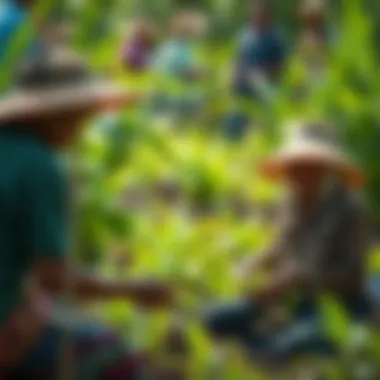Effective Strategies for Rainforest Conservation


Intro
The approaches we discuss will cover a spectrum ranging from individual actions to large-scale international policies. Emphasis will be placed on the importance of local initiatives, the role of sustainable agriculture, and the necessity for strong legal frameworks. There’s no silver bullet solution. Instead, a multidimensional strategy is required to bridge ecological preservation and community development, ensuring that both nature and human interests can thrive side by side.
As we delve into the depths of this issue, we will explore actionable insights that not only aim to mitigate deforestation but also foster community engagement and empowerment, strengthening the bonds between people and their environment.
Latest Trends in Agriculture
Overview of Current Trends
Agriculture's interplay with rainforest conservation is a double-edged sword. While traditional farming practices often lead to deforestation, innovative trends in agriculture are sprouting up to help turn the tide. Agroforestry, for instance, combines agriculture and forestry, allowing landholders to integrate trees and shrubs into their farming landscapes. This not only boosts biodiversity but also enhances soil health and reduces carbon emissions.
Another notable trend is organic farming, a method that avoids synthetic fertilizers and pesticides. Not only does this practice produce healthier crops, but it also lessens the chemical runoff that often contaminates local water systems. By catering to a growing market for organic produce, such methods can significantly impact land management and conservation efforts in rainforest areas.
Impact of Technology on Farming Practices
In the digital age, technology plays a pivotal role in reshaping agricultural practices. Precision agriculture harnesses data analytics and satellite imagery to maximize yield while minimizing waste. For example, farmers can now use drones to monitor crop health and soil conditions. This level of observation allows for targeted interventions, thereby reducing the need to expand agricultural land into fragile rainforest regions.
Moreover, mobile applications are becoming lifelines for farmers in rainforest-adjacent communities. These apps provide essential information on best practices, market prices, and even climate forecasts, enabling farmers to make informed decisions that can lead to both increased productivity and environmental stewardship.
"Integrating technology into farming practices is not merely a choice but a necessity in this era of climate change and environmental degradation."
Sustainable Practices: Towards a Greener Future
Importance of Sustainability in Agriculture
Sustainability is the gold standard all agricultural practices should aim for, especially in rainforest regions where ecosystem diversity is rich. Sustainable practices foster a relationship between the land and its caretakers, emphasizing long-term ecological balance over quick profits. By promoting crop rotation and soil conservation techniques, farmers can maintain fertility and reduce erosion.
Methods for Sustainable Farming
To pursue sustainability effectively, farmers can adopt several methods such as:
- Intercropping: Planting different crops in proximity to encourage biodiversity and maximize productivity while minimizing pest issues.
- Minimal Tillage: Reducing soil disruption preserves soil structure, aiding water retention and promoting a healthy microbial population.
- Cover Cropping: Using cover crops to protect against erosion, improve soil health, and fix nitrogen in the soil can make a significant difference.
These methods not only protect the valuable ecosystems but can contribute significantly to the farmers' bottom line, creating a win-win scenario.
Gardening Techniques and Tips
Essential Gardening Tools and Equipment
While many may think gardening is solely for personal use, community gardening initiatives have gained traction as effective approaches for rainforest conservation. Essential tools include:
- Hand trowel: For digging and planting.
- Pruners: To maintain plant health and encourage growth.
- Watering can: To ensure adequate moisture without overwhelming the plants.
Seasonal Gardening Practices
Adapting gardening practices according to seasons can greatly benefit both gardens and the surrounding rainforest. Knowing when to plant certain species can lead to a more resilient garden:
- Spring is perfect for planting fast-growing, native plants that can enrich biodiversity.
- In summer, nurturing plants becomes paramount, as rainfall patterns shift; mulching can retain soil moisture.
- During autumn, it’s a great time to compost fallen leaves and prepare the garden beds for winter, ensuring a healthy start for the next planting season.
By integrating such techniques into community initiatives, local farmers and residents can work towards not just their food security but also the vitality of the rainforest ecosystems surrounding them.
Understanding Rainforest Ecosystems
Rainforest ecosystems are nothing short of miraculous. They form the backbone of the Earth's biodiversity, acting as both a haven for countless species and a critical component of our global climate system. To truly grasp the significance of conserving these magnificent realms, it's vital to explore their importance, the biodiversity they host, and the different types of rainforests that exist.
The Importance of Rainforests
Rainforests are often referred to as the planet's lungs. These vast, green expanses contribute significantly to oxygen production and play a pivotal role in regulating weather patterns and storing carbon. In fact, they absorb more carbon dioxide than they release, making them invaluable in the fight against climate change.
Moreover, rainforests offer resources that are integral to human survival. They provide essential raw materials like timber, medicinal plants, and food products, and their ecosystems contribute to the livelihoods of millions of people, particularly in indigenous communities. The loss of rainforests could lead to the extinction of not just the flora and fauna within them but also deeply impact human societies reliant on these ecosystems.
Biodiversity and Ecological Functions
One of the defining characteristics of rainforest ecosystems is their extraordinary biodiversity. Rainforests house more than half of the world’s terrestrial plant and animal species. To break it down further, they perform some remarkable ecological functions. These include:
- Soil formation: The lush vegetation contributes to rich soil nutrients, crucial for sustaining diverse wildlife.
- Water cycle regulation: Rainforests influence local and global water cycles, helping to maintain precipitation patterns.
- Habitat creation: The multi-layered structure of rainforests provides varied niches that support diverse organisms.
This intricate web of life not only fosters resilience within the ecosystem itself but plays a key part in global ecological stability.
Types of Rainforests
Not all rainforests are created equal. They can be broadly categorized into two types: tropical and temperate rainforests. Understanding their unique characteristics offers insight into their respective contributions to the global ecosystem.
Tropical Rainforests
Tropical rainforests are perhaps the most renowned of all rainforest types. Found near the equator, these forests boast year-round warmth and high humidity. A key characteristic of tropical rainforests is their staggering diversity. They are home to trees that reach impressive heights and compete for sunlight in a layered canopy structure.
The unrivaled biodiversity within tropical rainforests supports various ecological functions. For instance, they are hotspots for medicinal plants, many of which have been used in traditional and modern medicine. However, their high susceptibility to deforestation due to agricultural expansion is a significant concern. Encouraging sustainable farming practices can help mitigate such threats while ensuring the protection of these vital ecosystems.
Temperate Rainforests
In contrast, temperate rainforests are located in cooler coastal regions, such as the Pacific Northwest of the United States. These forests have a unique aspect: they experience significant seasonal changes, including wet winters and dry summers, which shape their diverse plant and animal life. A notable feature of temperate rainforests is their towering coniferous trees, which provide not only wood products but also help stabilize soil against erosion.
Though temperate rainforests may not have the same level of biodiversity as their tropical counterparts, they deliver significant ecological benefits. For instance, they play a role in carbon storage and have a rich understory of ferns and shrubs, fostering wildlife. However, like tropical rainforests, they face threats from logging and climate change, emphasizing the need for robust conservation strategies.
"The conservation of rainforests is not merely an environmental issue, but a human rights and social justice issue as well."
A nuanced understanding of rainforest ecosystems, including their importance, biodiversity, and types, sets the stage for exploring effective strategies for conservation. Addressing these complex challenges requires thorough knowledge and committed action from all parties involved.
Major Threats to Rainforests


Understanding the major threats to rainforests is vital for crafting effective strategies for their conservation. This section examines three principal hazards: deforestation and land conversion, climate change impact, and illegal wildlife trade. Each area presents unique challenges that demand attention and informed responses. By identifying and addressing these threats, we can bolster efforts aimed at preserving these irreplaceable ecosystems.
Deforestation and Land Conversion
Deforestation, often driven by agricultural expansion, logging, and urbanization, remains one of the most pressing threats to rainforests. Once a lush green canopy, forest land is now frequently turned into farmland or grazing pastures. The consequences of this are dire, affecting not only regional biodiversity but also the global climate. In humid tropical areas, where many of the world's rainforests thrive, removing trees can unleash significant amounts of carbon dioxide into the atmosphere, worsening the greenhouse effect.
"Forests act like the planet's lungs, absorbing carbon dioxide and releasing oxygen. When they disappear, we all pay the price."
In Brazil, the phenomenon is particularly evident. Large tracts of the Amazon rainforest have disappeared, mostly due to cattle ranching and soy cultivation. It’s essential to acknowledge that while agricultural practices provide food and income, there needs to be a balance to ensure that forest ecosystems can thrive. This calls for sustainable farming methods that can safeguard forests while fulfilling human demand.
- Benefits of Sustainable Land Use:
- Maintains ecological balance.
- Protects water resources.
- Preserves habitats for wildlife.
Policymakers and local communities must collaborate on strategies that minimize land conversion without compromising agricultural productivity.
Climate Change Impact
Climate change serves as a dual threat to rainforests. Not only does it cause shifts in weather patterns, making regions more prone to drought, but it also uplifts the intensity of storms. Forests, accustomed to stable climates, become stressed as sudden changes disrupt their natural cycles, hindering growth and reproduction.
For instance, in Indonesia, unpredictable monsoons have started to affect the regeneration of tree species that have adapted to a specific climactic rhythm. This disruption can lead to decreased resilience against pests and diseases, further threatening these ecosystems. Addressing climate change impacts involves integrating local wisdom into modern ecological practices. Encouraging adaptation strategies is critical for forest survival.
- Adaptation Strategies Include:
- Enhancing forest resilience.
- Implementing water conservation practices.
- Developing climate-resilient crop varieties.
Illegal Wildlife Trade
The illegal wildlife trade poses a substantial threat not only to individual species but to rainforest ecosystems as a whole. Animals like the orangutan and various bird species are targeted for their fur, feathers, or as exotic pets. This trade depletes populations and disrupts ecological balances. When these animals vanish, the repercussions ripple throughout the ecosystem. For example, herbivores may overconsume certain plants, leading to diminished plant diversity and, ultimately, habitat degradation.
Public awareness campaigns play a crucial role in combatting illegal wildlife trade. The more that communities understand the value of local wildlife and the consequences of its loss, the more likely they are to become advocates for conservation.
- Key Solutions:
- Strengthening law enforcement against poaching.
- Promoting ecotourism to reduce pressure on wildlife.
- Educating communities about the importance of biodiversity.
By addressing these threats, we can foster an environment conducive to the protection and preservation of rainforest ecosystems. Through collaborative endeavors involving communities, governments, and businesses, our collective action can turn the tide against these growing challenges.
Community Involvement in Conservation
Community involvement in rainforest conservation is not just a passing trend; it’s a cornerstone for any successful strategy aimed at preserving these vital ecosystems. Local communities are often the very first line of defense against environmental degradation. By incorporating indigenous practices and local knowledge, conservation efforts can become significantly more effective. Not only do these communities often have a deep-rooted understanding of their environment, but they also possess the traditional methods for sustainable living, which can help balance conservation with their daily needs. Involving these communities fosters a sense of ownership, motivating them to engage in conservation, ensuring that their unique insights and values are respected.
The benefits of local engagement extend far beyond mere ecological outcomes. When communities are actively involved in conservation, they can reap several socio-economic rewards:
- Improved Livelihoods: Sustainable practices can lead to longer-term financial stability while preserving natural resources.
- Cultural Preservation: Involving indigenous peoples helps maintain cultural identities, traditions, and languages that might otherwise fade.
- Social Cohesion: Collaborative efforts in conservation can strengthen bonds within communities, enhancing social capital.
However, consideration must be given to the complexities that arise when involving local communities in conservation initiatives. Not all community practices are sustainable, and influence from external factors—such as market demands or governmental policies—can compromise traditional methods. Awareness and education play crucial roles in navigating these challenges and ensuring that community-led efforts align with broader conservation goals.
Indigenous Knowledge and Practices
Indigenous knowledge and practices represent a treasure trove of information when it comes to rainforest conservation. These systems of understanding—shaped by generations of interaction with the environment—provide insights that modern science often overlooks. For instance, traditional agricultural practices, such as slash-and-burn, have been honed over centuries to benefit both crop yields and ecosystem health. While it might sound counterintuitive, these practices can be adapted to promote biodiversity instead of causing harm when applied in moderation.
In many cases, indigenous groups have developed methods for managing lands that don’t deplete resources but rather enrich them. When these techniques are respected and integrated into modern conservation strategies, they can lead to a more balanced coexistence of human activities and nature. Moreover, by recognizing the value of these indigenous insights, conservationists can foster partnerships that enable a two-way learning process, where both parties can teach and learn from each other’s practices.
"The voice of indigenous peoples is paramount in the quest to sustain the planet’s rainforests. Their knowledge systems are often finely tuned to the local ecosystems where they reside, making them invaluable allies in conservation."
Community-Led Conservation Initiatives
Efforts at grassroots levels frequently lead the charge in effective conservation practices, as seen through various community-led initiatives around the world. These initiatives often emerge from a collective desire to protect local environments while simultaneously improving quality of life. A notable example is the community forestry programs in Nepal, where local communities manage forest resources sustainably, resulting in increased forest cover and community resilience against climate change.
Community-led approaches often grant stakeholders a say in the decision-making processes affecting their lands. Such empowerment breeds accountability, as people feel directly invested in the results of their conservation efforts. Besides, successes typically lead to positive feedback loops, building community confidence in pursuing further initiatives.
Some aspects that highlight the effectiveness of community-led campaigns include:
- Management Flexibility: Communities often possess the agility to adapt quicker than larger organizations can in the face of changing conditions.
- Resource Mobilization: Local knowledge can help in tapping into natural resources sustainably.
- Awareness: Community members who are educated about the significance of conservation are more likely to advocate for maintaining their environment.
Yet, the uniqueness of each community must be taken under advisement. There isn’t a one-size-fits-all approach. Conservation leaders must remain sensitive to the socio-cultural contexts of these groups and allow their initiatives to evolve organically based on local needs, challenges, and successes.
For deeper exploration on this topic, resources like Wikipedia, Britannica, and various academic journals from *.edu domains can offer a wealth of information.
Sustainable Agricultural Practices
Sustainable agricultural practices are vital for the conservation of rainforests, playing a critical role in balancing the needs of human populations with the preservation of rich ecosystems. By employing methods that cause minimal environmental disruption, farmers can produce food while safeguarding the biodiversity that characterizes these ecosystems. Essentially, the goal is to create agricultural systems that provide ongoing productivity without depleting natural resources or threatening ecological integrity.
Importance of Sustainable Agricultural Practices
The importance of sustainable agricultural practices can hardly be overstated. As rainforests continue to face threats from deforestation and land conversion, implementing sustainable practices in agriculture serves multiple purposes:
- Biodiversity Conservation: Sustainable practices promote crop diversity and protect wildlife habitats, thereby preserving the natural ecological balance within rainforest regions.
- Soil Health: By using techniques such as cover cropping and crop rotation, farmers help maintain soil nutrients and prevent erosion, fostering healthier ecosystems.
- Water Conservation: Sustainable farming often incorporates methods for rainwater harvesting and efficient irrigation, which help manage water resources better.
- Climate Resilience: These practices can enhance the resilience of farming systems against climate fluctuations, reducing vulnerability to extreme weather events.
Considering these benefits, adopting sustainable agricultural practices should be a priority for farmers. They not only help in maintaining the ecological health of rainforest regions but also ensure that agricultural activities remain viable in the long term.
Agroforestry Systems
Agroforestry, the integration of trees and shrubs into agricultural landscapes, offers a practical solution for conserving rainforests while simultaneously enhancing agricultural productivity. This approach serves as a striking example of how agriculture can coexist with forest ecosystems. Agroforestry systems typically involve:
- Tree Crops: Farmers can plant fruit trees alongside crops, which not only provide food but also create habitat for local wildlife.
- Shade-Grown Coffee: Coffee grown under a canopy of trees supports biodiversity and can yield a high-quality product without harming the rainforest.
- Timber Production: Sustainable timber harvesting can provide income while maintaining tree cover, thus protecting the forest structure.
Agroforestry systems not only improve crop yields but also enhance soil quality, control pests naturally, and offer shaded areas that can help mitigate the heat on otherwise exposed land. This system works in harmony with rainforest ecosystems, creating a sustainable model for agricultural practices.
Organic Farming Techniques
Organic farming techniques present an alternative to conventional agriculture's often harmful methods, emphasizing natural processes and cycles. This approach plays a significant role in rainforests by avoiding synthetic pesticides and fertilizers, which can lead to soil degradation and water contamination.


Some key components of organic farming include:
- Crop Rotation: Changing the types of crops grown in a specific area aids in preventing pest outbreaks and maintaining soil nutrients.
- Natural Fertilizers: Utilizing compost and manure keeps harmful chemicals out of the soil and promotes healthy microbial communities.
- Integrated Pest Management (IPM): By observing crop fields regularly and using non-chemical methods to control pests, farmers help maintain the ecological balance while minimizing chemical use.
The transition to organic farming benefits rainforest conservation efforts as it reduces environmental stress imposed by industrial agricultural practices. Furthermore, organic produce often fetches a higher market price, providing economic incentives for farmers to adopt these environmentally-friendly methods.
"Sustainable agriculture is not merely a set of practices but a commitment to preserving the earth’s natural resources for future generations."
For a deeper understanding of sustainable practices, you can explore resources at Wikipedia and Britannica. Visit your local agricultural extension services for specialized advice suited to your region.
Legislation and Policy Frameworks
Legislation and policy frameworks play a pivotal role in the conservation of rainforests. Without robust laws and effective regulations, preserving these biodiverse ecosystems becomes an uphill battle. Such frameworks provide the necessary structure for action against threats like deforestation, poaching, and unsustainable land development. They establish guidelines for sustainable resource management, which is vital for maintaining ecological balance while allowing local communities to thrive.
An effective legal framework can attract investment in conservation efforts. This not only addresses the economic aspects but also ensures that local populations benefit from preserving their environment. Policymakers must consider the voices of indigenous people, whose traditional knowledge is invaluable for sustainable practices. Laws and policies must be inclusive and adaptable, allowing various stakeholders—governments, NGOs, private sectors, and local communities—to collaborate.
National Policies for Rainforest Conservation
National policies are essential as they set the tone for rainforest conservation within a country. Each country often has its unique legal system and governance structure, which can either aid or hinder conservation efforts. For example, Brazil's Forest Code has been both criticized and praised; while it aims to regulate land use, loopholes enable unsustainable practices. Countries can benefit from studying and learning from each other's experiences.
In many nations, national policies surrounding rainforest conservation include:
- Protected Areas Designation: Such policies often lead to the establishment of national parks and conservation areas.
- Sustainable Development Goals (SDGs): These policies help align national interests with global conservation strategies.
- Incentive Programs: Incentives for sustainable practices can help reduce deforestation rates, such as tax breaks for eco-friendly farming.
It's vital that these policies are continuously evaluated. An adaptable approach can help refine strategies, fostering resilience against emerging threats such as climate change or economic pressures.
International Agreements and Treaties
International agreements and treaties represent a collective commitment among nations to confront environmental challenges that transcend borders, such as rainforest depletion. One significant example is the Paris Agreement, which aims to limit global temperature rise and indirectly supports rainforests as crucial carbon sinks. Such frameworks hold countries accountable, providing mechanisms for monitoring and reporting progress.
Other notable agreements include the Convention on Biological Diversity, which emphasizes the preservation of ecosystems, including rainforests. By having binding agreements, nations can work together, sharing technology, resources, and knowledge to reinforce their efforts.
Key elements of successful international treaties often include:
- Shared Funding: Financial support for conservation initiatives, particularly in developing countries.
- Capacity Building: Training and resources for local governments and communities to implement conservation practices effectively.
- Public Awareness: Engaging citizens globally on the importance of rainforests can drive grassroots movements that push for political action.
These collaborative efforts create a stronger, unified front in the battle against rainforest degradation, demonstrating that rainforest conservation is not just a local issue but a global necessity.
The power of legislation lies not just in its enactment, but in its effective enforcement and the commitment of all stakeholders to work towards a common goal.
Technological Innovations in Conservation
In the world of rainforest conservation, technological advancements shine as a beacon of hope. The role of innovative technology is becoming quite significant in protecting these vital ecosystems. Utilizing cutting-edge tools not only boosts the efficiency of conservation efforts but also enhances our understanding of the complex interplay of factors influencing rainforest health. As agriculture farmers and enthusiasts, recognizing the intersection between technology and conservation can illuminate pathways for sustainable practices and community engagement.
Remote Sensing and Monitoring
Remote sensing technology leverages satellite imagery and aerial surveys to track changes in rainforest landscapes. It provides comprehensive data that assists in monitoring logging activities, land use changes, and even the health of tree canopies. These tools allow conservationists to observe vast areas without the need for on-the-ground surveys, which can be time-consuming and costly.
- Benefits of Remote Sensing:
- Timely Data Collection: Enables near real-time tracking of deforestation activities.
- Large-Scale Observations: Monitors extensive regions that may otherwise go unnoticed.
- Historical Comparisons: Facilitates the analysis of data over time to detect long-term environmental trends.
Remote sensing also aids in disaster monitoring, for instance, detecting damage from wildfires or floods. By analyzing satellite images, researchers can assess the extent of damage and implement recovery strategies more effectively. As an imperative aspect of rainforest conservation, the technology underscores the importance of informed decision-making to prevent further degradation.
Biotechnology Applications
Biotechnology is another avenue transforming conservation strategies, especially in how we interact with rainforest agricultural practices. This field encompasses advancements from genetic modifications to biopharmaceutical developments, contributing to ecosystems' resilience.
- Key Biotechnology Innovations:
- Genetically Modified Organisms (GMOs): Crops engineered for improved yield or resistance to pests can reduce the need for harmful pesticides that damage ecosystems.
- Bioremediation: Utilizing microbes to clean up pollutants in rainforest areas can restore damaged habitats without harming existing flora and fauna.
- Conservation of Genetic Diversity: Biobanks store genetic material from endangered species, allowing for breeding programs aimed at restoring populations in the wild.
Biotechnology offers smart solutions tailored to the unique challenges of rainforest preservation. For instance, creating pest-resistant plant varieties can help farmers reduce their reliance on chemical pesticides, which can wash into nearby water sources and impact local wildlife. Overall, the application of biotechnology in agriculture not only promotes conservation but also aligns with the broader goals of sustainable farming practices.
"Technological advancements are not just tools; they are a vital part of creating a sustainable future for our rainforests."
The Role of Education and Awareness
Educating individuals and creating awareness about rainforest conservation plays a pivotal role in shaping collective attitudes toward environmental stewardship. Without knowledge, action regarding the protection of these essential ecosystems can be shallow or misinformed. Education empowers communities, enhances responsibility, and can turn passive concerns into robust advocacy. When people understand the critical value of rainforests, the biodiversity they support, and the environmental services they provide, they are more likely to participate in conservation efforts.
Additionally, awareness campaigns can bridge the gap between scientific understanding and public perception. By highlighting stories of local flora and fauna, anniversaries of important ecological milestones, or innovative agricultural practices that respect rainforest ecosystems, these initiatives can motivate action. They offer a platform to discuss the potentially devastating effects of deforestation, promoting a sense of urgency that can mobilize public interest and government action. Seeing tangible benefits, like the preservation of clean water sources or improved soil health, can resonate with communities, compelling them to advocate for sustainable practices.
"Education is not the filling of a pail, but the lighting of a fire." – William Butler Yeats
Public Awareness Campaigns
Public awareness campaigns serve as a foundational strategy in the fight for rainforest conservation. These programs often utilize various media, such as social media, documentaries, workshops, and community gatherings, to disseminate vital information about rainforests. Campaigns like the Earth Hour or World Rainforest Day not only raise awareness but also encourage individuals to change their behaviors, reduce waste, and contribute to reforestation projects. They highlight the connection between everyday actions, like purchasing sustainable products, and the health of rainforests.
Some effective components of public awareness campaigns include:
- Storytelling: Sharing real-life stories from indigenous communities or conservationists can humanize the issue.
- Statistics and Facts: Presenting compelling data can inform and spark conversation.
- Visual Aids: Stunning images of biodiversity or time-lapses of deforestation can be more impactful than words alone.
A well-executed campaign can inspire grassroots movements and prompt policy changes. As an example, the campaign to protect the Amazon rainforest saw local communities empowered to stand against illegal logging by harnessing public support through awareness initiatives.
Integrating Conservation in Education
Integrating conservation into educational curricula ensures that young minds understand the importance of rainforests from an early age. Imagine a classroom where children learn not only about the science of ecosystems but also the cultural and economic implications of rainforest depletion. Schools can implement hands-on projects such as school gardens that incorporate local native plants, allowing students to grasp lessons on biodiversity right in their backyard.
Key strategies for integrating conservation include:
- Curriculum Development: Educators can collaborate with conservationists to develop methodologies that integrate rainforest topics across science, geography, and even social studies.
- Workshops and Field Trips: Taking students out of the classroom, whether it’s to local forests or urban recycling centers, can offer practical insights into ecosystem management and responsible behavior.
- Engagement with NGOs: Schools can partner with organizations focused on conservation efforts, inviting guest speakers or participating in joint conservation initiatives.
By merging education and conservation, communities can cultivate a knowledgeable generation that values and promotes sustainable practices, fostering a widespread ethic that champions the health of rainforests not as a distant concern, but as part of their everyday lives. This awareness and every small action contribute to a larger movement for conservation.


Corporate Responsibility and Sustainable Business Practices
Corporate responsibility and sustainable business practices have become essential components in the effort to conserve rainforests. The engagement of businesses in environmentally friendly initiatives is not only beneficial for the planet but also fosters goodwill with consumers and communities. It is critical that businesses recognize their role in protecting these vital ecosystems. When companies prioritize sustainability in their operations, they directly contribute to preserving biodiversity and reducing deforestation. More than just a fad, these practices reflect a growing awareness that ecological health is intertwined with long-term business viability.
The benefits of green business models go beyond just positive public relations. Companies that adopt eco-friendly practices often experience cost savings through efficiencies and waste reduction. Furthermore, they gain competitive advantages in a marketplace that increasingly values sustainability. From sourcing materials responsibly to integrating renewable energy sources, there are myriad ways businesses can align their practices with rainforest conservation.
Eco-friendly Business Models
Implementing eco-friendly business models is a pivotal strategy for positively impacting rainforest ecosystems. These models often focus on the following elements:
- Sustainable Sourcing: Companies can prioritize materials that are harvested sustainably. For instance, wood products should come from certified forests that practice reforestation.
- Waste Management Strategies: Effective practices like recycling and composting can reduce landfill contributions significantly. This minimizes habitat destruction caused by waste disposal.
- Energy Efficiency: Adopting renewable energy sources, such as solar or wind, can lessen dependence on fossil fuels, driving down carbon emissions.
"Implementing sustainable practices ensures that businesses contribute positively to the environment while achieving economic success."
Adopting such models not only helps to protect rainforests but also grows an organization's reputation. Companies willing to make these changes often find they resonate with customers who value environmental sustainability.
Corporate Sponsorship of Conservation Projects
Sponsoring conservation projects is another critical avenue through which corporations can exercise their responsibility towards rainforest preservation. Corporate sponsorship can provide significant funding and resources to initiatives aimed at protecting diverse ecosystems. Here are some noteworthy considerations:
- Local Partnerships: Collaboration with local communities means businesses can support projects tailored to specific ecological and cultural needs. This local approach encourages participation and supports indigenous knowledge.
- Long-term Commitments: Businesses can maximize their impact by committing to long-term funding for conservation. As rainforests require sustained efforts for preservation, such commitments can lead to meaningful, lasting change.
- Public Engagement: Corporations can engage their customers by promoting these partnerships. Marketing campaigns that showcase their efforts not only raise awareness but also encourage customers to make more eco-friendly choices.
For more on sustainable business practices, you can explore resources like Business for Social Responsibility or the World Resources Institute.
Global Partnerships and Collaboration
In the quest for conserving rainforests, the importance of global partnerships and collaboration cannot be overstated. Collaboration unifies various stakeholders, blending resources, knowledge, and strategies towards a common purpose: safeguarding these vital ecosystems. Working together, nations, organizations, and communities can develop comprehensive approaches that are often more effective than isolated efforts.
When multiple parties come to the table, they bring diverse perspectives and expertise. This kind of teamwork fosters innovation in conservation techniques and promotes the sharing of successful practices applicable in different contexts. For instance, by teaming up, local communities can learn from organizations with more experience in habitat restoration, while conservationists can gain insights from indigenous knowledge that has been perfected over generations.
NGOs and Local Communities
Non-Governmental Organizations (NGOs) play a pivotal role in matchmaking between local communities and broader conservation efforts. They often act as bridges, facilitating communication, and ensuring that the concerns and needs of local populations are addressed. These NGOs frequently sponsor grassroots initiatives, where community members come together to plant trees, protect wildlife habitats, and raise environmental awareness.
The benefits of involving local communities cannot be emphasized enough. When locals are engaged, they become stewards of the forests rather than mere observers. Their involvement brings about a vested interest in conservation; they stand to gain not only from the ecosystem's health but also from potential economic opportunities that come with sustainable practices, like eco-tourism or organic farming. A recent study found that when communities are actively involved, deforestation rates can drop by up to 50%.
"Empowering local communities leads to more sustainable conservation. Their traditional practices and urgent perspectives can inform cutting-edge conservation strategies."
International Conservation Organizations
International conservation organizations heighten the effectiveness of local efforts through global funding, expertise, and advocacy. Groups like the World Wildlife Fund (WWF) and Conservation International engage in projects that span continents, focusing on rainforest preservation as a key global priority.
These organizations often help train local leaders and stakeholders, equipping them with the tools necessary to implement conservation strategies. They lobby for policies that protect rainforests at both local and international levels, making them instrumental in forming important agreements.
The synergy created between these organizations and local efforts can serve as a blueprint for future conservation endeavors. Their insights into international policy can lead to stronger protections for vulnerable regions and species.
The collaboration that emerges from partnerships with international organizations can also bring attention to critical issues, mobilizing resources that might not be available otherwise. By leveraging global networks, local initiatives can gain visibility and support, cultivating a stronger commitment to rainforest conservation worldwide.
Measuring Success in Conservation
Measuring success is vital when it comes to rainforest conservation. It is not enough to have good intentions; the effectiveness of various strategies must be assessed to ensure that the actions taken truly make a difference. Knowing whether we are moving the needle in the right direction impacts funding, policy decisions, and community involvement. By establishing clear metrics, conservationists can not only track progress but also identify areas that may need more attention or a shift in strategy. Together, these elements create a comprehensive framework that facilitates ongoing dialogue about conservation efforts.
Setting Conservation Goals
Setting tangible goals acts like a compass for conservation initiatives. These benchmarks provide teams with a clear direction and measurable targets, aiding in resource allocation and strategic planning. It’s like having a map on a journey; without defined goals, you might find yourself wandering aimlessly, missing key destinations along the way.
Goals should be Specific, Measurable, Achievable, Relevant, and Time-bound (SMART). For instance, a simple goal could be to increase the tree canopy by 20% over five years. Such specificity allows for focused efforts and enables stakeholders to gauge success effectively.
Goals can include:
- Restoration Efforts: Aim to restore degraded areas within a specified timeframe.
- Biodiversity Checklists: Set targets for species population increases or the introduction of previously endangered species.
- Community Engagement: Include metrics for the number of local families participating in conservation strategies.
Working towards these goals requires collaboration between local communities, non-governmental organizations, and government entities, ensuring that everyone is on the same page.
Evaluating Conservation Programs
Evaluation of conservation programs is where the rubber meets the road. This involves systematically assessing the effectiveness of initiatives against the goals set earlier. It provides a reality check on whether efforts are translating into real benefits for both people and ecosystems. Without regular evaluations, there is a significant risk of continuing practices that don’t yield results, akin to throwing good money after bad.
During evaluations, various criteria could be examined:
- Ecological Impact: Assess the health of wildlife populations and ecosystem recovery.
- Economic Benefits: Determine whether conservation efforts lead to sustainable income for local communities.
- Social Dimensions: Examine the level of local engagement and whether people feel empowered by conservation strategies.
Regular evaluations help in adapting methods and expanding successful initiatives while scaling back on ineffective ones. They are essential for ensuring that every effort made is building toward more robust rainforest ecosystems.
"Success is not simply the absence of failure; it's the measured improvement in both ecological and social landscapes."
This ongoing evaluation of goals and programs establishes a feedback loop where adaptation and responsiveness become part of the conservation lexicon.
To further this understanding, resources such as Wikipedia's overview of conservation success measures and National Geographic's policy discussions can be beneficial for deeper insights.
Ending: A Call to Action
The urgency to protect rainforests cannot be overstated. These vibrant ecosystems are not only home to an astounding variety of species but also play a critical role in climate regulation and provide livelihoods for countless communities worldwide. Yet, every day, these natural treasures face unprecedented threats from deforestation, climate change, and unsustainable practices. This is a wake-up call for all of us—those who depend on the land, the scientists studying the ecosystems, and the policymakers drafting legislation.
Collaborative Efforts Needed
Coming together is the name of the game when it comes to conserving rainforests. Individual efforts can feel like a drop in the bucket. However, when communities, governments, NGOs, and businesses partner, it creates a formidable force for change. Consider, for instance, the collaboration between local indigenous groups and international organizations. This symbiosis marries traditional knowledge with modern conservation techniques.
- Empowering Local Voices: It’s crucial to ensure that indigenous peoples, who often have the most intimate knowledge of their ecosystems, are included in conservation strategies. Their practices — honed over generations — can provide invaluable insights into sustainable land management.
- Shared Initiatives: Projects that unify resources and expertise can amplify impact. This could include joint funding initiatives for reforestation or shared technology for monitoring deforestation.
- Education and Community Engagement: Building awareness at the community level can drive grassroots movements that push for policy changes. When people see the tangible benefits of conservation, like better soil health or increased biodiversity, they're more likely to support sustainable practices.
As the old saying goes, "many hands make light work." By pooling resources and knowledge, we can tackle these daunting challenges more effectively.
The Next Steps Forward
While we’ve laid out the case for urgent action, it’s equally important to pinpoint the specific steps we can take moving forward. Here are suggestions that can guide future endeavors in rainforest conservation:
- Local Action Plans: Each region should be equipped with tailored action plans. These plans should incorporate ecological assessments, community needs, and economic considerations to maximize effectiveness.
- Incorporate Technology: Leverage advances in technology such as satellite imaging and drones to monitor rainforest health. These tools can also aid in tracking illegal logging activities, which is crucial for enforcement.
- Policy Advocacy: Engaging in advocacy efforts to strengthen legal frameworks governing rainforest land is essential. This can involve pushing for stricter penalties for illegal practices and ensuring that conservation laws are enforced.
- Support Sustainable Businesses: Seek out and support companies that prioritize eco-friendly practices. Your purchasing power can send clear signals that sustainability is non-negotiable. Consider brands like Patagonia, which invests in conservation, or local farmers who practice agroforestry.
- Foster International Coalitions: Global collaboration is key. As the world grows increasingly interconnected, solutions to shared problems must transcend borders. Organizations like the World Wildlife Fund (WWF) and Conservation International are already making strides, but they need robust support.
In the end, the health of our planet hinges on the preservation of rainforests. If we unite efforts, educate one another, and push for actionable strategies, we can turn the tide on deforestation and ensure these ecosystems thrive for generations to come. Let’s not just talk about it; let’s take firm action that echoes our commitment to preserving the Earth’s lungs for the future.







